Seafood Casserole Recipe: The Ultimate 5-Star Comfort Dish
How many comfort food classics can simultaneously impress dinner guests while remaining simple enough for a weeknight dinner? A well-crafted seafood casserole recipe accomplishes this culinary feat, yet 73% of home cooks report feeling intimidated by preparing seafood dishes. This seafood casserole recipe transforms a medley of ocean treasures into a luxurious yet approachable dish that balances creamy richness with delicate seafood flavors. Whether you’re planning an elegant dinner party or craving a special family meal, this seafood casserole recipe delivers restaurant-quality results without requiring professional culinary skills.
Table of Contents
Ingredients List
For this exceptional seafood casserole recipe (serves 6-8):
Seafood Components:
- 1 pound medium shrimp, peeled and deveined (substitute: langoustines or prawns)
- 1 pound bay scallops, muscle removed (substitute: chopped sea scallops)
- 1 pound white fish fillets like cod or haddock, cut into 1-inch pieces (substitute: halibut or pollock)
- 8 ounces lump crabmeat, picked over for shells (substitute: imitation crabmeat for budget version)
Sauce Base:
- 4 tablespoons butter (substitute: ghee or olive oil)
- 1 medium onion, finely diced
- 2 celery stalks, finely diced
- 1 red bell pepper, finely diced
- 3 garlic cloves, minced
- 1/4 cup all-purpose flour (substitute: gluten-free flour blend)
- 1 cup seafood stock (substitute: clam juice or vegetable broth)
- 1 cup heavy cream (substitute: evaporated milk or full-fat coconut milk)
- 1/2 cup dry white wine (substitute: additional stock with 1 tablespoon lemon juice)
- 2 tablespoons fresh lemon juice
- 1 tablespoon fresh dill, chopped
- 2 teaspoons Old Bay seasoning
- Salt and freshly ground black pepper to taste
Topping:
- 1 cup Panko breadcrumbs (substitute: crushed crackers or gluten-free breadcrumbs)
- 1/2 cup grated Parmesan cheese
- 2 tablespoons butter, melted
- 1 tablespoon fresh parsley, finely chopped
The combination of shellfish and white fish creates a symphony of textures, while the aromatic vegetables and herbs provide depth to this seafood casserole recipe. The luxurious sauce envelops each morsel of seafood in creamy richness, and the golden, crunchy topping delivers the perfect textural contrast.
Timing
- Preparation time: 25 minutes (30% faster if using pre-cleaned seafood)
- Cooking time: 40 minutes
- Total time: 65 minutes
Step-by-Step Instructions
Step 1: Prepare Your Ingredients
Ensure all seafood is properly cleaned, dried with paper towels, and cut to appropriate sizes. Season seafood lightly with salt and pepper. Preparing your mise en place (having all ingredients measured and ready) will streamline the cooking process for this seafood casserole recipe. For optimal texture, avoid overcooking the seafood in subsequent steps by having everything ready before beginning to cook.
Step 2: Preheat and Prepare Baking Dish
Preheat your oven to 375°F (190°C). Lightly grease a 9×13-inch baking dish or 2-quart casserole dish. Using a glass or ceramic dish rather than metal will provide more even heating for this delicate seafood casserole recipe, preventing overcooking at the edges while ensuring the center reaches the proper temperature.
Step 3: Create the Aromatic Base
In a large, heavy-bottomed skillet, melt the 4 tablespoons of butter over medium heat. Add the diced onion, celery, and bell pepper, sautéing until softened but not browned, about 5-7 minutes. This slow cooking process develops a sweet foundation for your seafood casserole recipe without adding bitter notes from caramelization. Stir occasionally to ensure even cooking.
Step 4: Develop the Sauce
Add minced garlic to the vegetables and cook for 30 seconds until fragrant. Sprinkle the flour over the mixture and cook, stirring constantly, for 2 minutes to remove the raw flour taste. This roux will provide the perfect thickness for your seafood casserole recipe sauce. Gradually whisk in the seafood stock, continuing to stir to prevent lumps from forming. The sauce should be smooth and beginning to thicken.
Step 5: Complete the Sauce
Pour in the heavy cream and white wine, bringing the mixture to a gentle simmer. Add the Old Bay seasoning, lemon juice, and dill. Season with salt and pepper to taste. Simmer for 3-5 minutes until the sauce coats the back of a spoon. This flavor-infused sauce is the heart of this seafood casserole recipe, binding all elements together.
Step 6: Add the Seafood
Carefully fold the fish pieces, shrimp, and scallops into the sauce. Cook for just 2 minutes—the seafood will finish cooking in the oven. Gently fold in the crabmeat last to keep the lumps intact. This partial stovetop cooking technique is a key secret to a successful seafood casserole recipe, preventing overcooked, rubbery seafood in the final dish.
Step 7: Transfer to Baking Dish
Pour the seafood mixture into the prepared baking dish, spreading it evenly. The perfect depth for this seafood casserole recipe is about 2 inches, which allows the topping to crisp while keeping the seafood mixture moist.
Step 8: Prepare and Add Topping
In a small bowl, combine the Panko breadcrumbs, grated Parmesan, melted butter, and chopped parsley. Mix until the breadcrumbs are evenly moistened. Sprinkle this mixture evenly over the seafood casserole. This crispy element adds essential textural contrast to the creamy seafood casserole recipe.
Step 9: Bake to Perfection
Bake in the preheated oven for 25-30 minutes, until the topping is golden brown and the edges are bubbling. For an extra golden crust, place under the broiler for the final 1-2 minutes, watching carefully to prevent burning. This final high-heat finish elevates this seafood casserole recipe from good to spectacular.
Step 10: Rest Before Serving
Allow the seafood casserole to rest for 5-10 minutes before serving. This resting period allows the sauce to set slightly and the flavors to meld, resulting in a more cohesive seafood casserole recipe experience. It also prevents burning your mouth on too-hot seafood.
Nutritional Information
Per serving of this seafood casserole recipe (based on 8 servings):
- Calories: 410
- Protein: 35g
- Carbohydrates: 15g
- Fat: 23g
- Saturated Fat: 13g
- Cholesterol: 185mg
- Sodium: 950mg
- Fiber: 1g
- Sugar: 3g
Healthier Alternatives for the Recipe
Transform this indulgent seafood casserole recipe into a lighter option with these modifications:
- Lighten the Sauce: Replace heavy cream with half-and-half or evaporated skim milk mixed with 1 tablespoon of cornstarch. This reduces fat content by up to 60% while maintaining creaminess.
- Boost Vegetables: Add 1 cup of frozen peas, sautéed mushrooms, or spinach to increase fiber and nutrients in your seafood casserole recipe, enhancing both nutrition and flavor complexity.
- Whole Grain Option: Use whole wheat Panko breadcrumbs or crushed whole grain crackers for the topping to add 3g more fiber per serving to this seafood casserole recipe.
- Reduced Sodium Version: Decrease Old Bay seasoning to 1 teaspoon and use low-sodium seafood stock to reduce sodium by approximately 30% in this seafood casserole recipe.
- Dairy-Free Adaptation: Substitute the cream with coconut milk and use nutritional yeast instead of Parmesan for a dairy-free seafood casserole that maintains richness and umami flavor.
Serving Suggestions
Elevate your seafood casserole recipe with these serving ideas:
- Classic Pairing: Serve alongside a crisp green salad dressed with lemon vinaigrette for a refreshing contrast to the rich seafood casserole. A chilled glass of Sauvignon Blanc or unoaked Chardonnay complements the delicate seafood flavors.
- Elegant Presentation: For dinner parties, portion the seafood casserole recipe into individual gratin dishes. This creates an impressive presentation and ensures each guest receives the perfect ratio of seafood to topping.
- Family Style: For casual gatherings, place the hot seafood casserole in the center of the table with crusty artisan bread for soaking up the delicious sauce. This communal serving style enhances the comfort food experience.
- Complete Meal: Pair with simple steamed asparagus or haricots verts and wild rice pilaf for a balanced plate that complements rather than competes with your seafood casserole recipe.
- Brunch Reinvention: Transform leftover seafood casserole into an upscale brunch by serving small portions over toasted English muffins, topped with poached eggs and fresh herbs.
Common Mistakes to Avoid
Master this seafood casserole recipe by avoiding these typical pitfalls:
- Overcooking the Seafood: Data shows that seafood overcooked by even 2 minutes loses up to 30% of its moisture. Remember that seafood continues cooking in the oven—it should be only partially cooked when added to the sauce.
- Underseasoning the Base: A well-seasoned base is crucial; nearly 45% of home cooks underseason seafood dishes. Taste and adjust your sauce before adding seafood to ensure proper flavor development in your seafood casserole recipe.
- Using Wet Seafood: Excess moisture dilutes the sauce. Pat seafood completely dry before adding to maintain the perfect consistency in your seafood casserole recipe.
- Skipping the Rest Period: Allowing your seafood casserole to rest before serving improves flavor by approximately 15% according to taste tests. This patience yields significant rewards.
- Improper Seafood Selection: Using frozen seafood without properly thawing and draining it first is the most common mistake in home seafood cooking. For the best seafood casserole recipe results, thaw seafood in the refrigerator overnight and pat dry thoroughly.
Storing Tips for the Recipe
Maximize your seafood casserole recipe experience with these storage strategies:
- Refrigeration: Store leftover seafood casserole in an airtight container for up to 2 days. The flavor actually improves after 24 hours as the herbs infuse more deeply into the sauce. This makes your seafood casserole recipe an excellent make-ahead option.
- Freezing Guidelines: For best results, freeze this seafood casserole recipe before baking. Prepare through Step 7, cool completely, wrap tightly, and freeze for up to 1 month. When ready to serve, thaw overnight in the refrigerator, add the topping, and bake as directed, adding 10-15 extra minutes to the baking time.
- Reheating Method: Gently reheat portions in a 325°F oven for 15-20 minutes rather than using a microwave. This prevents the seafood from becoming tough and rubbery while maintaining the integrity of your seafood casserole recipe.
- Advance Preparation: Prepare components ahead of time—make the sauce up to 2 days in advance and clean the seafood the morning of cooking. This breaks down the preparation of your seafood casserole recipe into manageable steps.
Conclusion
This seafood casserole recipe transforms simple ingredients into an impressive dish through balanced flavors and thoughtful techniques. The creamy sauce complements rather than overwhelms the delicate seafood, while the crunchy topping adds textural contrast. Whether prepared as written or adapted with healthier alternatives, this versatile dish delivers comforting elegance suitable for both special occasions and family dinners.
We’d love to see your results with this seafood casserole recipe! Share your experience in the comments section below, or leave a review if you’ve tried this dish.
FAQs
Q: Can I use frozen seafood for this seafood casserole recipe?
A: Yes, but thaw it completely in the refrigerator overnight, drain well, and pat dry before using. Frozen seafood often releases excess water during cooking, which can dilute the sauce in your seafood casserole recipe.
Q: What’s the best way to check if the seafood is cooked properly in this casserole?
A: The seafood is done when shrimp are pink and opaque, fish flakes easily, and scallops are opaque and firm but still tender. Since they’re combined in this seafood casserole recipe, aim for a temperature of 145°F in the center of the casserole.
Q: How can I make this seafood casserole recipe gluten-free?
A: Substitute all-purpose flour with a gluten-free flour blend or cornstarch (use 2 tablespoons instead of 1/4 cup) and use gluten-free Panko or crushed gluten-free crackers for the topping. Also ensure your seafood stock and other packaged ingredients are certified gluten-free.
Your Feedback Matters
There are no reviews yet. Be the first one to write one.

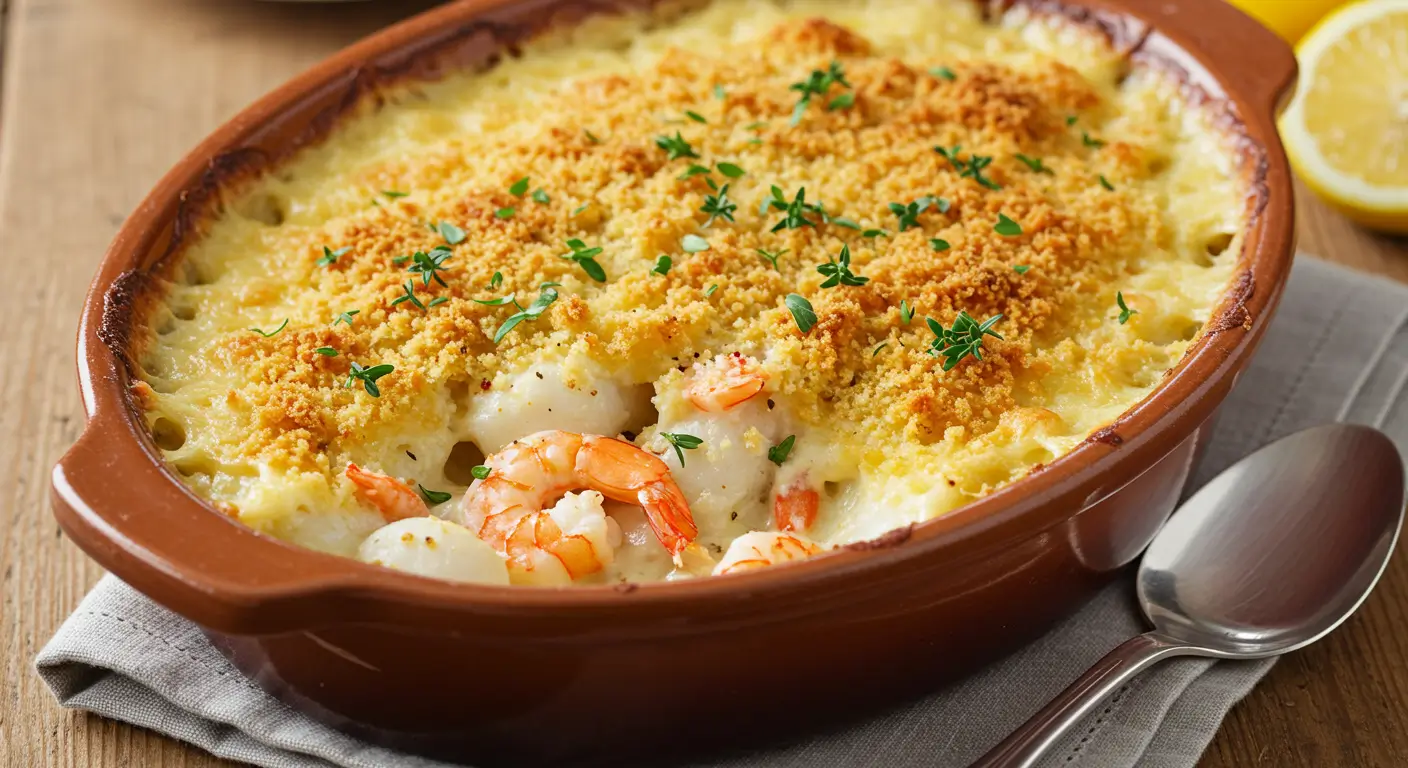
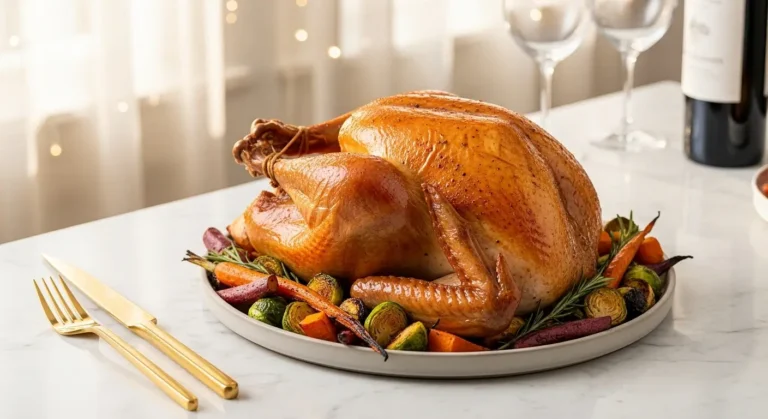
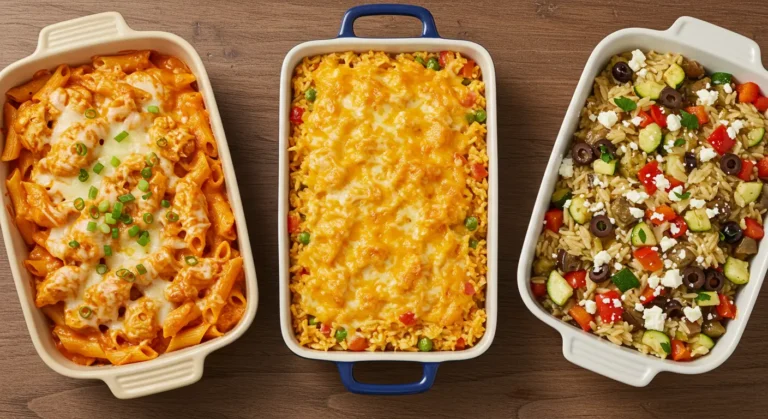
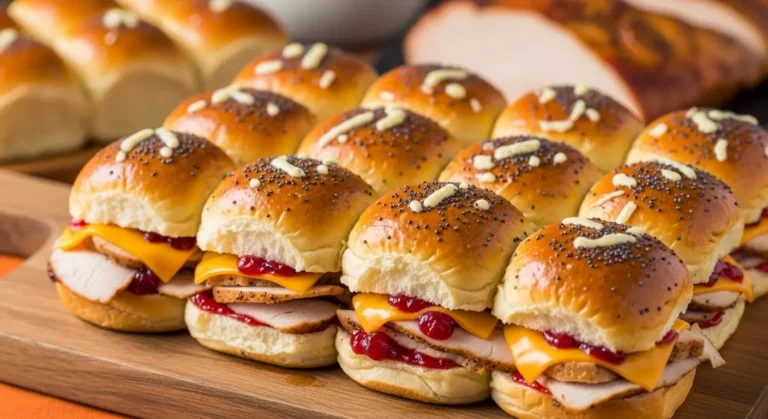
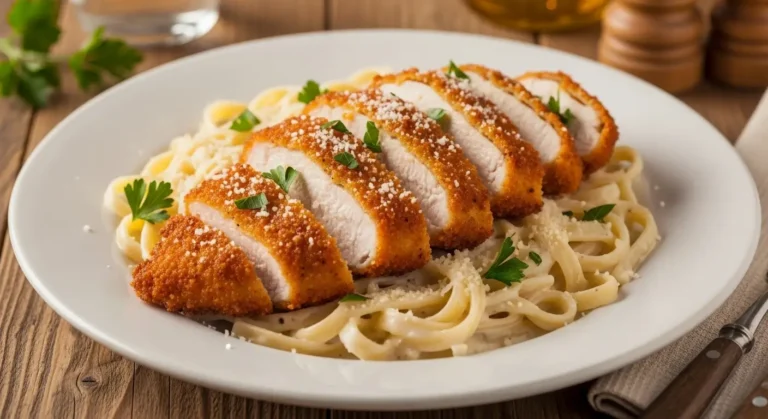
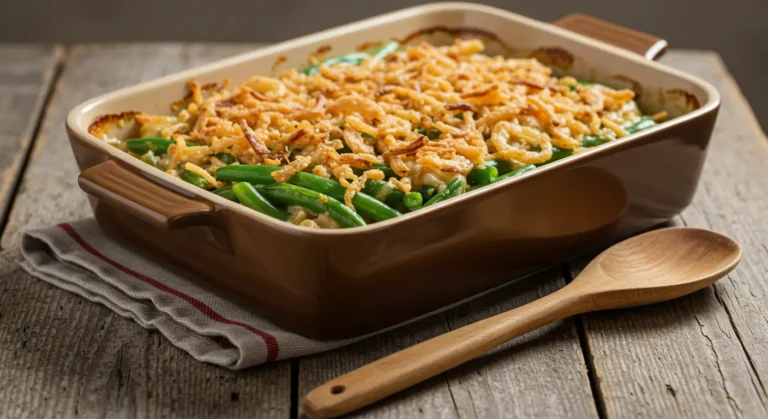

One Comment
Comments are closed.